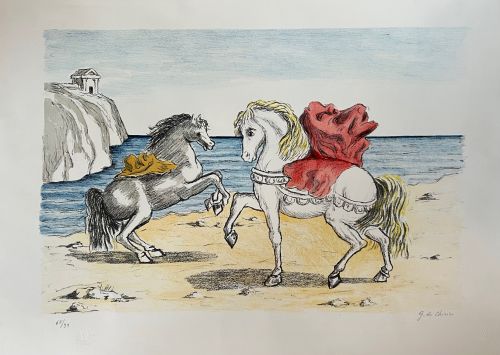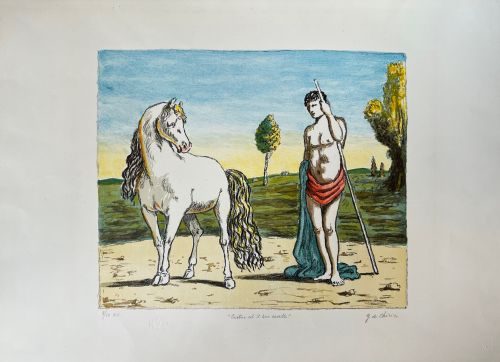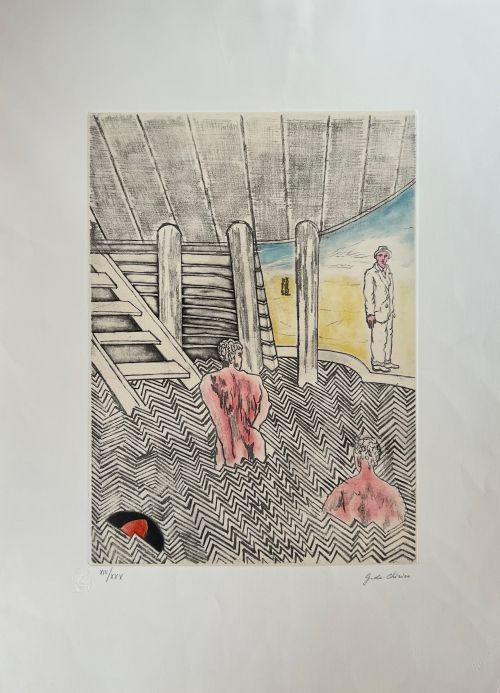About the artist:
Italian artist, the largest representative of "metaphysical" painting, the predecessor of Surrealism.
Born in the Greek, Giorgio de Chirico was the son of Italian parents.
In 1906 he moved to Munich, where he attended the Akademie der Bildenden K?nste. At this time de Chirico
became interested in the art of Arnold Becklin and Max Klinger and the writings of Friedrich Nietzsche and Arthur
Schopenhauer. These philosophers played a crucial role in the development of his art style.
In 1910, de Chirico moved to Paris, where he became friends with the poets Valery and Apollinaire, but was alien
to the Cubism movement, which, thanks to Picasso, was of great artistic interest. De Chirico also always
remained a stranger to the Avant-Garde, to which he often expressed political views.
During those years, the artist painted many of his most famous paintings, which belong to the "Piazze d'Italia"
series. These paintings depict images of classical architecture or architectural elements which often appear cold
and disjointed, as though they are uninhabited, situated amidst long angled planes of space. De Chirico uses
rows of archways and columns to direct the viewer's eye across the uncertain landscape.
In 1916, de Chirico met a prominent representative of Futurism, Carlo Carra in a military hospital in Ferrara.
Together they developed a theory of metaphysical painting. The term "metaphysics" was born as an allusion to a
different reality that goes beyond what we see, when objects or spaces known to us from our experience, as it
were, reveal a new aspect that surprises us. And so things known to us take the form of riddles, mysteries,
inexplicable secrets.
While most of de Chirico's metaphysical images are devoid of real human life or hint at it far away in the distance,
he often included mannequin-like figures with no facial features. These anonymous bodies imbue the setting with
a sense of anonymity and mystique. It is hard to say where and when these strange figures exist.
From 1918 to 1922, de Chirico actively participated in the life of the famous Italian art magazine "Valori Plastici",
where he published an article entitled "The Return of Craftsmanship", in which he advocated a return to
traditional methods and iconography. This article heralded an abrupt change in his artistic orientation, as de
Chirico adopted a classicizing manner inspired by such old masters as Raphael and Signorelli, and became part
of the post-war return to order in the arts. He became an outspoken opponent of modern art.
In 1924 he returned to Paris, where he often visited a group of surrealists. Despite the fact that the Surrealists
recognized De Chirico as one of their predecessors, the Italian artist never agreed to integrate into their poetics or
style because this emphasis on the dream dimension, consisting of unconscious automatisms, was alien to him.
Later, De Chirico's painting turned more and more to archaeological classicism, where the use of mythologies
was always interpreted metaphysically, which, however, remained his main love. And he kept returning to
metaphysics in subsequent years as well.
The works of Giorgio De Chirico are represented in the collections of many major museums: the Museum of New
and Contemporary Art of Trento and Rovereto, the Centre Pompidou, the Victoria and Albert Museum, the
Museum of Modern Art, the Tate, the Peggy Guggenheim Collection, among others.








